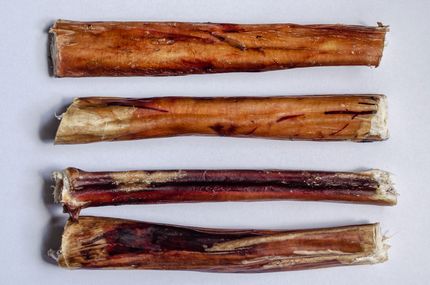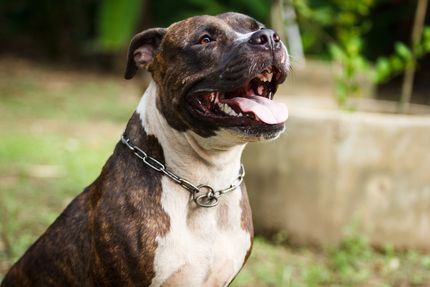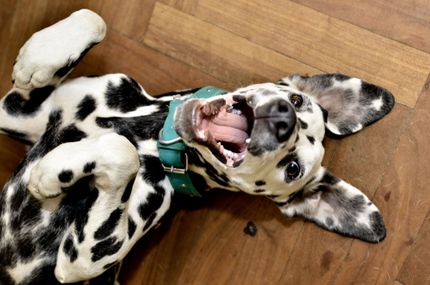Facts & Origin
What is a Saint Berdoodle?
The Saint Berdoodle is a so-called designer dog that was created by crossing a St. Bernard with a poodle. This mix combines the gentle giant character of the St. Bernard with the intelligence and allergy-friendliness of the poodle. The result is a large, friendly and often curly-haired family dog that can be used both as a companion and as a therapy or working dog. Its appearance can vary greatly depending on genetics and breeding goals.
There is no firmly established German name for the Saint Berdoodle. Occasionally, terms such as Bernhardinerdoodle or Bernhardoodle are used, but they are not standardized and hardly widespread.
Origin: The mixture of strength and intelligence
The breeding of the Saint Berdoodle began - as with many doodle breeds - from the desire to combine the advantages of two very different breeds. The Saint Bernard stands for good-naturedness, closeness to family and a protective instinct, while the Poodle stands for high intelligence, a love of learning and a slightly hairy coat. The aim was to create a large dog with a social nature, easy to train and possibly a hypoallergenic coat. This mix became particularly popular in the USA - both as a pet and in animal-assisted work.
Criticism: Between fashion dog and responsibility
As with many doodle mixes, the Saint Berdoodle has also been criticized, especially in animal welfare circles. The desire for ever new "hybrid breeds" often leads to uncontrolled breeding without health standards. With breeds as different as the Saint Bernard and the Poodle, it is also uncertain which characteristics will prevail: Size, weight, coat type, temperament - all of these can vary greatly from litter to litter. The idea that an "allergy-friendly giant dog" is automatically easy to care for is an illusion. Serious breeding requires genetic knowledge, health checks and long-term responsibility - not spontaneous trendy thinking.
Suitability: Who is the Saint Berdoodle suitable for?
The Saint Berdoodle is generally a gentle, people-oriented and intelligent dog that is well suited as a family or therapy dog. It needs space, time and loving consistency to develop well. The coat - especially if curly or dense - also requires regular grooming. However, those who are willing to put in the effort will be rewarded with a loyal, friendly and impressive companion who often surprises with his gentle nature.
| Alternate Name | Saint Bernard Doodle, Saint Bernardoodle |
| Origin | Switzerland - Germany |
| Life expectancy | 8 - 15 years |
| Care requirements | high-maintenance |
| Activity level | average - average to high |
| FCI group | not recognised |
| AKC group | not recognised |
| KC group | not recognised |
More Saint Bernard mixes
More Poodle mixes
Attitude, character and temperament of the breed
Character: Gentle giant with brains
The Saint Berdoodle often combines the calm, loving nature of the St. Bernard with the intelligence and temperament of the poodle. The result is usually a balanced, people-oriented and sensitive dog that fits in well with families and also gets on well with children or other animals. Many Saint Berdoodles show a high degree of adaptability and are both cuddly and playful. At the same time, they bring a certain sensitivity with them - typical Poodle characteristics such as alertness and reactivity can occur. Gentle but consistent training is important so that the dog finds security and orientation. Thanks to their social nature, many representatives of this mix are also suitable as therapy or visiting dogs.
Character
Usage
Health and care: Large, friendly - and high-maintenance
In terms of health, Saint Berdoodles can benefit from the robust sides of both breeds but can also be susceptible to typical hereditary diseases of large dogs. These include hip dysplasia, elbow dysplasia, heart disease, gastric torsion and eye diseases. Epilepsy or skin problems can also occur - especially if breeding has not been carried out carefully.
Grooming and care require time and attention. The coat in particular can vary greatly - from curly to wavy to slightly smooth - and tends to become matted depending on its structure. Regular brushing (several times a week) and occasional trimming or clipping are necessary. Attention should also be paid to ear care, as Poodle or St. Bernard ears can easily accumulate moisture. These dogs also need daily physical exercise, although they are not high-performance athletes - long walks, play and moderate activity are usually sufficient.
What does this mixed breed look like?
Visually, the Saint Berdoodle is an impressive dog, combining the size and mass of the St. Bernard with the often more elegant, softer appearance of the Poodle. The shoulder height is usually between 60 and 75 cm, the weight can vary between 35 and 60 kg. The build is strong but not heavy, with a friendly, often "smiling" facial expression. The eyes are usually dark and gentle, the ears hang down to medium length.
The coat varies greatly - both in texture and color. White-brown, black-white or cream tones are typical, sometimes with striking markings. Curly animals in particular are strongly reminiscent of oversized teddy bears. Overall, despite its size, the Saint Berdoodle often appears soft, inviting and friendly, which suits its nature perfectly.
| Fur length | medium |
| Fur | flat coated - curly |
| Ear shape | Floppy Ear |
| Tail | fanned out - lang |
| Anatomy | strong, slim, sporty |
| Size ♀ | 45 - 80 cm |
| Weight ♀ | 18 - 120 kg |
| Size ♂ | 45 - 90 cm |
| Weight ♂ | 18 - 120 kg |
| Suitable For | - |
Known Diseases
Epilepsy
Definition: Dog has epilepsy if, for example, at least two epileptic seizures occur more than 24 hours apart.
Cancer
May be common in older dogs.
Skeletal disorders
IPA, FPC and OCD occur in dogs at four to five months of age during the most severe growth spurt.
Cataract
Cataracts are still one of the most common causes of blindness, even in dogs.
Progressive Retinal Atrophy (PRA)
Progressive retinal atrophy (PRA) is a slowly progressive death of the retina in dogs.
Patellar problems
Problems with the Patellar can be a displacement or weak kneecap, which is one of the most common causes of lameness in dogs, also because of overweight.
Eye diseases
Often occur with allergies and intolerances.
FAQ
-
A Saint Berdoodle is a hybrid dog breed created by crossing a Saint Bernard with a poodle. These dogs are usually large and have a dense, fluffy coat.
-
Saint Berdoodles usually weigh between 35-60 kg. They have a strong and muscular body and a dense coat that can be either black, brown or white.
-
The average life expectancy of a St. Bernard-Poodle mix is 10-12 years.
-
Saint Berdoodles are generally good with children and other pets. They are known to be loyal, affectionate and intelligent dogs.
-
Common health problems in St. Bernard and Poodle mixes include hip and elbow dysplasia, eye problems and bloat.





















